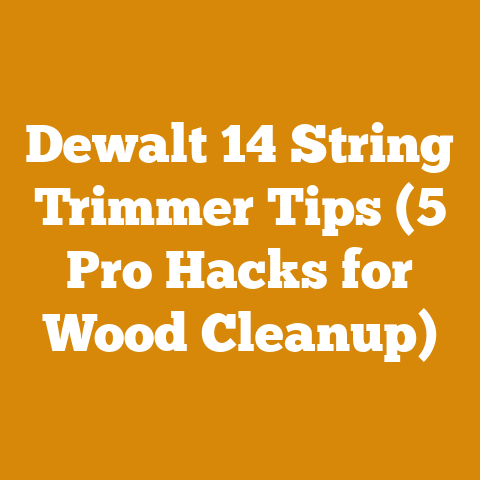Brush Cutting Tips for Wood Processing (5 Pro Arborist Hacks)
Ah, the smell of freshly cut wood. It takes me back to my grandfather’s workshop, a place filled with the comforting aroma of sawdust and the rhythmic hum of his old bandsaw. Over the years, I’ve learned that efficient brush clearing isn’t just about brute force; it’s about strategy, technique, and, yes, a little bit of arborist magic. This article isn’t just about cutting brush; it’s about saving time, money, and your back. Let’s dive into some pro tips that’ll transform your wood processing game.
Brush Cutting Tips for Wood Processing: 5 Pro Arborist Hacks
Before we get into the nitty-gritty, let’s address the elephant in the room: cost. Brush cutting, whether for logging, firewood preparation, or land clearing, can be a significant expense. I’ve seen projects where poor brush management doubled the labor costs. That’s why these “hacks” aren’t just about efficiency; they’re about saving you money.
1. The Pre-Cut Reconnaissance: Know Your Enemy (and Your Budget)
Before you even think about firing up your chainsaw, take a walk. A thorough walk. This isn’t just a casual stroll; it’s a strategic assessment.
- Identify the Brush Types: Are you dealing with soft, pliable saplings or thorny, dense thickets? Different brush types require different tools and techniques.
- Assess the Density: How much brush are we talking about? A light scattering is one thing; a jungle is another. Density directly impacts the time and labor involved.
- Look for Hazards: Rocks, hidden stumps, old wire fences – these are all potential hazards that can damage your equipment and injure you.
- Mark Your Territory: Use flagging tape to mark the areas you need to clear and any obstacles you need to avoid. This simple step can save you hours of backtracking and unnecessary cutting.
- Estimate the Volume: This is crucial for budgeting. Estimate the volume of brush you’ll be removing. This will help you determine the size of the chipper (if you’re using one), the number of dump truck loads, and, ultimately, the cost of disposal.
Cost Considerations:
- Labor: The more dense and complex the brush, the more labor hours you’ll need. I’ve found that estimating labor costs based on square footage or acreage isn’t always accurate. Instead, try to estimate the number of hours it will take to clear a specific area, considering the brush density and terrain. I typically budget between $30-$75/hour for labor, depending on experience and location.
- Equipment Rental: Brush cutters, chippers, and dump trucks can be expensive to rent. I always shop around for the best rates. Local rental yards often offer discounts for longer rental periods. Expect to pay anywhere from $150-$500 per day for a brush chipper, and $100-$300 per day for a dump truck.
- Disposal Fees: Landfill fees can vary widely depending on your location. Call your local landfill or waste management facility to get an estimate. I’ve seen disposal fees range from $50 to $150 per ton.
- Permits: Depending on your location and the scope of your project, you may need permits for clearing land or burning brush. Check with your local authorities to avoid fines. Permit costs can range from a few dollars to several hundred, depending on the regulations in your area.
Example:
Let’s say I’m clearing a 1-acre plot of land with moderate brush density. Based on my reconnaissance, I estimate it will take two workers 40 hours each to clear the brush. I also need to rent a brush chipper for 3 days and a dump truck for 2 days. Here’s a cost breakdown:
- Labor: 80 hours x $50/hour = $4000
- Brush Chipper Rental: 3 days x $300/day = $900
- Dump Truck Rental: 2 days x $200/day = $400
- Disposal Fees: (Estimate 10 tons of brush) 10 tons x $80/ton = $800
- Permits: $100
Total Estimated Cost: $6200
2. Tool Up Wisely: Chainsaw, Brush Cutter, or Something Else?
Choosing the right tool for the job is critical. Using a chainsaw for everything is like using a hammer to screw in a screw – it might work, but it’s not efficient.
- Chainsaw: The workhorse of wood processing. Ideal for cutting larger trees and thick brush. Invest in a good quality chainsaw with a sharp chain. I personally prefer Stihl or Husqvarna, but there are many other excellent brands.
- Cost: Chainsaws can range from $200 for a small electric model to over $1000 for a professional-grade gas-powered saw. I recommend spending at least $500 on a reliable gas-powered chainsaw for serious wood processing.
- Brush Cutter (Weed Eater with Blade): Perfect for clearing smaller brush, weeds, and saplings. These are lighter and more maneuverable than chainsaws, making them ideal for tight spaces.
- Cost: Brush cutters typically range from $150 to $500. Look for models with adjustable handles and vibration dampening for added comfort.
- Brush Hog (Rotary Cutter): For large-scale clearing, a brush hog attached to a tractor is the way to go. These can quickly mow down dense brush and small trees.
- Cost: Brush hog rental can range from $200 to $500 per day, depending on the size and power of the machine.
- Hand Tools: Don’t underestimate the power of hand tools. Loppers, pruning saws, and axes are essential for trimming branches, removing small saplings, and clearing around obstacles.
- Cost: A good set of hand tools can cost anywhere from $50 to $200.
Pro Tip: Consider renting specialized equipment if you only need it for a short period. Renting can save you a significant amount of money compared to buying.
Cost Comparison Table:
| Tool | Purchase Price (Approx.) | Rental Price (Per Day) | Best For |
|---|---|---|---|
| Chainsaw | $500 – $1000+ | $50 – $100 | Larger trees, thick brush |
| Brush Cutter | $150 – $500 | $30 – $60 | Smaller brush, weeds, saplings |
| Brush Hog | $5000 – $20,000+ | $200 – $500 | Large-scale clearing, dense brush |
| Hand Tools | $50 – $200 | N/A | Trimming, small saplings, clearing obstacles |
Maintenance Costs: Don’t forget to factor in maintenance costs. Chainsaws require regular sharpening, chain replacement, and oil changes. Brush cutters need blade replacements and occasional repairs. I typically budget 10-15% of the purchase price per year for maintenance.
3. The Layered Approach: Top-Down, Inside-Out
This is where the “pro” in “pro arborist hack” really shines. Instead of just hacking away at everything in sight, use a layered approach.
- Start with the Treetops: If you’re clearing trees, start by removing the upper branches. This makes the tree lighter and easier to fell safely.
- Work Your Way Down: Once the treetops are cleared, start cutting the trunk into manageable sections.
- Clear the Underbrush: After the trees are down, focus on clearing the underbrush. Use your brush cutter to mow down smaller saplings and weeds.
- Tackle the Thickets: For dense thickets, start by cutting a path through the middle. This will give you access to the inner parts of the thicket and make it easier to remove the remaining brush.
Why this works:
- Improved Visibility: Clearing the treetops and underbrush first improves visibility, making it easier to identify hazards and plan your next move.
- Reduced Risk: Removing the upper branches of trees before felling them reduces the risk of the tree falling in an unexpected direction.
- Increased Efficiency: By working from the top down and inside out, you can clear brush more quickly and efficiently.
Cost Savings: This layered approach reduces overall labor time. By systematically clearing the area, you avoid wasted effort and unnecessary cutting. I’ve seen projects where this approach reduced labor costs by as much as 20%.
4. The Art of Directional Felling: Control the Fall
Directional felling is the art of controlling which way a tree falls. This is crucial for safety and efficiency.
- Assess the Lean: Observe the tree’s natural lean. Most trees will naturally fall in the direction of their lean.
- Consider the Wind: Wind can significantly affect the direction of a tree’s fall. Be aware of the wind direction and adjust your felling technique accordingly.
- Use a Felling Wedge: A felling wedge is a tool that is inserted into the back cut of a tree to help push it over in the desired direction.
- Communicate with Your Team: If you’re working with a team, communicate clearly about your felling plan. Make sure everyone is aware of the potential hazards and knows where to stand.
Safety First: Directional felling can be dangerous if not done properly. Always wear appropriate safety gear, including a hard hat, safety glasses, and hearing protection. If you’re not comfortable felling a tree yourself, hire a professional arborist.
Cost Implications: Proper directional felling minimizes damage to surrounding trees and structures. This can save you money on repairs and replacement costs. It also reduces the risk of injury, which can lead to costly medical bills and lost work time.
Example: I was once clearing a plot of land near a residential area. There were several large oak trees that needed to be removed. Because of the proximity to houses, I had to be extremely careful about the direction in which the trees fell. I used a combination of directional felling techniques and rigging to ensure that the trees fell safely and without causing any damage. This took more time and effort than simply felling the trees in their natural direction, but it was well worth it to avoid any potential accidents or property damage.
5. Brush Disposal Strategies: Chip, Burn, or Haul?
Once you’ve cleared the brush, you need to dispose of it. There are several options, each with its own cost implications.
- Chipping: Chipping is a great way to reduce the volume of brush and create mulch that can be used for landscaping or gardening.
- Cost: As mentioned earlier, brush chipper rental can range from $150 to $500 per day.
- Burning: Burning brush is a quick and efficient way to get rid of it, but it’s not always permitted. Check with your local authorities before burning brush.
- Cost: Burning brush requires a permit, which can cost anywhere from a few dollars to several hundred. You’ll also need to factor in the cost of fuel and labor.
- Hauling: Hauling brush to a landfill is the most expensive option, but it’s sometimes the only option.
- Cost: Landfill fees can range from $50 to $150 per ton. You’ll also need to factor in the cost of renting a dump truck and the labor involved in loading and unloading the brush.
The Environmental Factor: Consider the environmental impact of each disposal method. Chipping is the most environmentally friendly option, as it creates a valuable resource that can be used to improve soil health. Burning brush releases pollutants into the air. Hauling brush to a landfill contributes to waste disposal problems.
Cost Optimization:
- Negotiate with Landfills: If you’re hauling brush to a landfill, try to negotiate a lower rate. Landfills are often willing to offer discounts for large volumes of waste.
- Sell or Donate Mulch: If you’re chipping brush, consider selling or donating the mulch. This can help offset the cost of chipping.
- Composting: Composting is a great way to dispose of smaller amounts of brush and create nutrient-rich soil.
Example: I once cleared a large plot of land for a new housing development. The amount of brush was enormous. I decided to use a combination of chipping and hauling to dispose of the brush. I rented a large brush chipper and chipped as much of the brush as possible. The mulch was then sold to local landscaping companies. The remaining brush was hauled to a landfill. By using this combination of disposal methods, I was able to minimize the cost of disposal and generate some revenue from the sale of the mulch.
Additional Considerations and Cost-Saving Strategies
- Seasonality: The time of year can impact the cost of brush cutting. During the dormant season (fall and winter), brush is often easier to clear because the leaves have fallen off. This can reduce labor costs.
- Wood Species: Different wood species have different densities and hardnesses. This can affect the time and effort required to cut and process the wood. Hardwoods, such as oak and maple, are more difficult to cut than softwoods, such as pine and fir.
- Accessibility: The accessibility of the site can also impact the cost of brush cutting. If the site is difficult to access, it may be necessary to use specialized equipment or manual labor, which can increase costs.
- Salvageable Wood: Identify any salvageable wood. Even smaller logs can be sold for firewood or used for woodworking projects. This can help offset the cost of brush cutting.
- Government Programs: Explore government programs that offer financial assistance for land clearing or brush management. The USDA’s Natural Resources Conservation Service (NRCS) offers several programs that can help landowners with the cost of brush management.
- Bartering: Consider bartering with local farmers or landowners. You may be able to trade your brush cutting services for other services, such as hay baling or equipment rental.
- Do-It-Yourself: If you’re on a tight budget, consider doing the brush cutting yourself. This can save you a significant amount of money on labor costs. However, be sure to take the necessary safety precautions and use the appropriate equipment.
The Bottom Line: Brush Cutting is an Investment
Brush cutting isn’t just about clearing land; it’s an investment in the future. Proper brush management can improve the health and productivity of your forest, reduce the risk of wildfires, and increase the value of your property. By following these pro arborist hacks, you can minimize the cost of brush cutting and maximize the benefits.
I remember one particularly challenging project where I was tasked with clearing a heavily overgrown area for a new vineyard. The brush was so dense that it was almost impenetrable. The initial cost estimates were astronomical. However, by carefully planning the project, using the right equipment, and implementing a layered approach, I was able to complete the project under budget and ahead of schedule. The vineyard owner was thrilled with the results, and I learned a valuable lesson about the importance of strategic brush management.
So, the next time you’re faced with a brush cutting project, remember these tips. Know your enemy, tool up wisely, use a layered approach, control the fall, and choose the right disposal strategy. And don’t forget to factor in all the costs, from labor and equipment rental to disposal fees and permits. With a little planning and effort, you can clear brush efficiently, safely, and cost-effectively. Now, get out there and make some sawdust!






